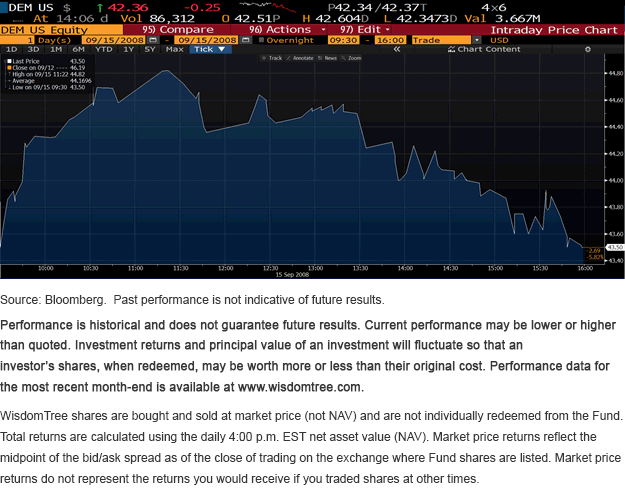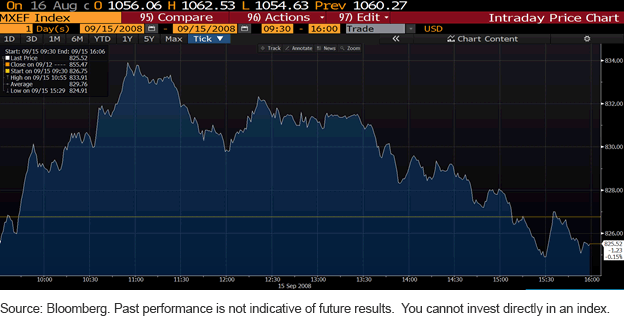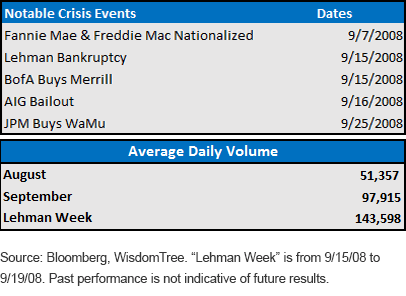ETFs: Saviors in Crises, Treated Like Pariahs


This is the final post in a four-part blog series addressing the attacks on smart beta and exchange-traded funds (ETFs). Today we touch on the argument that asset classes such as emerging markets, which typically have a liquidity fear hanging over them in crises, will see exacerbated downside in the next crisis because of the presence of ETFs in the system.
Always Remember: ETFs Saved Hides as Lehman Buckled
We often say that attacking ETFs for causing crises is like saying that online travel websites are the cause of hotel and airplane bookings. The argument that ETFs exacerbate crises is particularly preposterous because it comes after one of the few corners of the market in which many people seek out and find liquidity during panics, then spins the story around into one in which the very presence of the investment vehicle (like a junk bond ETF, etc.) somehow exacerbates illiquidity.
When making their argument, attackers usually focus on riskier assets classes, including just about everything in the emerging world, plus any kind of credit that is below investment grade, but we have seen the argument applied to all marketable securities.
As we look back at the global financial crisis and forward to inevitable future crises, we need to remember that every transaction has a seller and a buyer. In a crisis, ETFs can foster price discovery at the broad market level and allow bottom-up investors to have a point of reference for when they engage in classic individual security analysis. ETFs can provide the gift of reliable price transparency1 because of their intraday trading. They offer a real-time window into the true degree of panic or euphoria that may be occurring as a crisis unfolds.
DEM During Lehman’s Collapse
Perhaps the experience of the WisdomTree Emerging Markets High Dividend Fund (DEM) during the global financial crisis can provide a glimpse into what an ETF investor in a volatile asset class would have confronted during those dark days.
The intraday trading action in DEM on September 15, 2008, the day Lehman Brothers went bankrupt, is shown in figure 1. Optically, it appears that the largest drop-off in price from one trade to the next occurred between 11:42 a.m. and 11:47 a.m., in a move that took DEM from $44.6599 to $44.36. However, it is tough to see with the naked eye, but there actually were two other trades in that window, one that also came at 11:42 a.m. and another at 11:46 a.m. Investors who were using limit orders and were looking for trade execution were finding a market for their trades with frequency throughout the trading session. Keep in mind too that this was occurring in an ETF that was brand new at the time, in an environment in which many investors were not yet using ETFs, in an asset class that could have theoretically frozen up completely as the system imploded.
Figure 1: The WisdomTree Emerging Markets High Dividend Fund, 9/15/08

Please click here for DEM standardized performance.
Also, when we compare DEM’s ostensibly volatile moves that day, that wasn’t something that was unique to the WisdomTree Emerging Markets High Dividend Index or to DEM, which tracks it. The MSCI Emerging Markets Index that the WisdomTree index is often compared to was moving to and fro in a similar manner that day (figure 2).
Figure 2: MSCI Emerging Markets Index, Day of Lehman Bankruptcy (9/15/08)

Many investors were able to turn to ETFs during Lehman’s collapse because they were finding bids and offers when they needed them most. In Figure 3, we see that DEM’s average daily volume rose from 51,357 shares in August 2008 to 97,915 shares in September. In the week after the Lehman news, an average 143,598 shares were changing hands every day. For small investors, they could enter the market and have limit orders filled in the teeth of a crisis, every day, while creation/redemption was, of course, available for larger players and institutions.
Figure 3: WisdomTree Emerging Markets High Dividend Fund, August/September 2008

In short, one could say ETFs clear the market. We know their net asset value at a moment in time, and they provide a real-time glimpse at broad pricing, especially if they trade every second or two. Such action on the tape provides critical information to the individual buyer of riskier or more esoteric asset classes.
In turn, the availability of that information allows the transaction of individual bank loans, individual high-yield bonds, individual emerging market stocks and bonds, individual everything, to be exchanged with more confidence. Both buyer and seller are armed with knowledge—and that knowledge comes from ETF activity.
This breeds confidence and brings forth a critical mass of players on both the buy and sell sides of a market, much more so than before the advent of ETFs, when many securities would change hands “by appointment.” Those days are fewer now.
ETFs provided this information to all of us. They allowed individuals and money managers to buy (or short) individual securities with more confidence, knowing that on a moment’s notice they can go into the market and hedge their position by taking the other side of a trade across a broad market basket. Mutual funds did not give us this transparency, a reality that is all too evident to anyone who has been caught on the wrong side of a volatile market while they sweat the clock in anticipation of 4 p.m. EST. In the meantime, mutual fund owners have to count down as they are impotent to protect themselves intraday. Those days are fewer now.
It’s high time for this industry to ask the mutual fund complex why exactly it wishes in vain for this critical source of liquidity and valuable market information to disappear. Read about the differences between ETFs and mutual funds here.
1Holdings are displayed daily.
Important Risks Related to this Article
There are risks associated with investing, including possible loss of principal. Foreign investing involves special risks, such as risk of loss from currency fluctuation or political or economic uncertainty. Funds focusing on a single sector generally experience greater price volatility. Investments in emerging, offshore or frontier markets are generally less liquid and less efficient than investments in developed markets and are subject to additional risks, such as risks of adverse governmental regulation, intervention and political developments. Due to the investment strategy of this Fund it may make higher capital gain distributions than other ETFs. Please read the Fund’s prospectus for specific details regarding the Fund’s risk profile.


